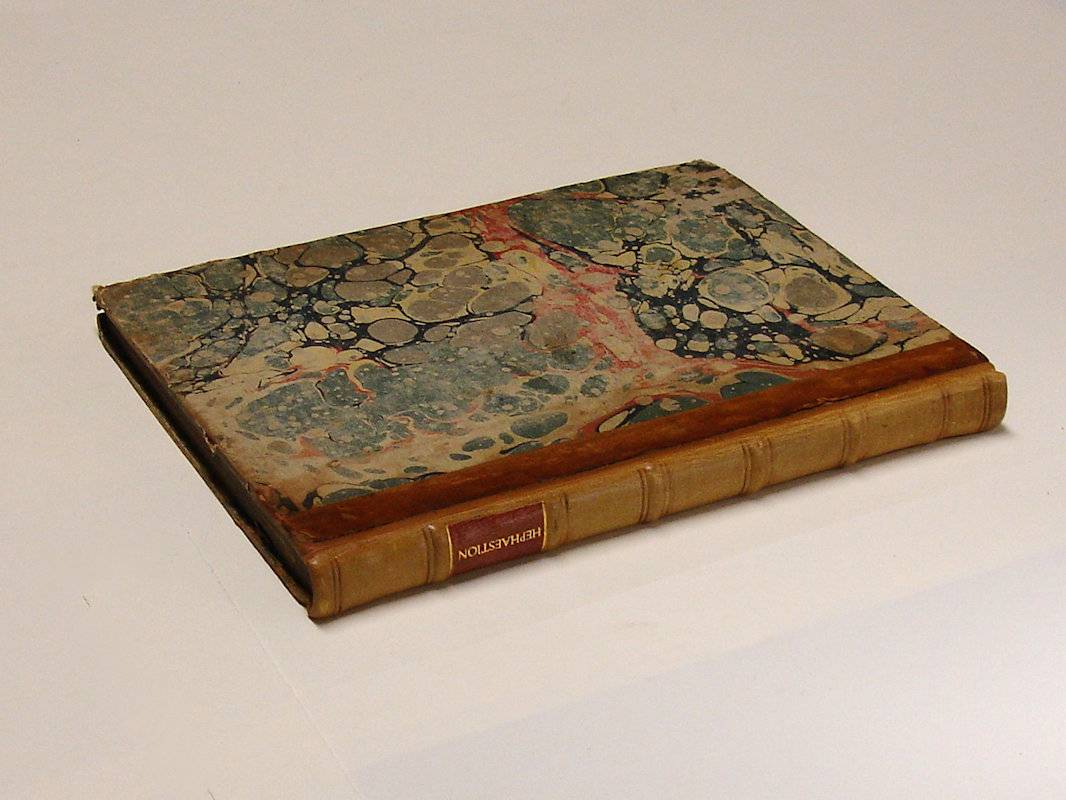HEPHAESTION.
HÊPHAISTIÔNÔS ALEXANDREÔS EGCHEIRIDION PERI METRÔN KAI POIÊMATOS. EIS TO AUTO SCHOLIA. Hephaestionis Alexandrini Enchiridion de metris et poemate. Cum scholiis antiquis, et animadversionibus Joannis Cornelii De Pauw.
Utrecht (Trajecti ad Rhenum), Apud Melchior. Leonardum Charlois, 1726. (Colophon at the end: Trajecti ad Rhenum, Typis Petri Muntendam)
4to. (IV),188,(7 index),(1) p. Half calf 21 cm (Ref: STCN ppn 185828795; Hoffmann 2,203; Brunet 5,104; Graesse 3,243; Ebert 9451) (Details: Back, rebacked antique style, with 5 raised bands, and with a red morocco shield in the second compartment. The boards are original and are covered with marbled paper. Woodcut printer's mark on the title, depicting the intertwined initials of M.L. Charlois. Edges dyed red) (Condition: Rebacked antique style. The paper on the boards is worn. Corners bumped. Upper margin of the first 2 leaves slightly waterstained) (Note: The study of metrics started already in the time of the Sophists. Herodotus knew iambic trimeters and hexameters. Later the Peripatetici and the Alexandrians developed the technical vocabulary and methods to analyse the metrical structure of lyric parts of Greek tragedies and comedies. What we know of ancient metrics was handed down to us by late antique and byzantine grammarians and commentators, especially by the Alexandrian scholar Hephaestion (second century A.D.) whose 'Enchiridion' summarizes ancient knowledge, and offers examples from works now lost. With the help of Hephaestion's handbook the Dutch scholar Willem Canter (Guilielmus Canterus), 1542-1575, rediscovered the metrical responsion in the lyrical parts of the plays of the Greek tragedians Aeschylus, Sophocles and Euripides, and was able to correct the corrupted text, using metrical responsion. 'Die Theorie des Hephaestion hat bis in moderne Darstellungen der Metrik hinein starke Nachwirkung gehabt'. (Neue Pauly 5,352) 'The terms in which he speaks of the metres of Greek verse and their properties have largely remained in use until the present day'. (Ophuijsen,J.M. van, 'Hephaestion on metre', Leiden 1987, p. 3) § Cornelis de Pauw, born ca. 1680 in Utrecht, was canon of the 'Sint Jan'. He was a classical scholar of some repute, and published several editions of Greek and Roman authors, Hephaestion, Horapollo, Anacreon, Quintus Smyrnaeus, Theophrastus's Characters, Phrynichus, Aeschylus. By some detractors he was considered to be an 'homme médiocrement savant', whose ignorance was only exceeded by his impudence. He died in 1749. De Pauw tells us in the short preface, that he based his edition on that of the French scholar Hadrianus Turnbebus, 'quae nitidissima est', which was published in Paris in 1553. The 'editio princeps' dates from 1526 (Florence). De Pauw follows Turnebus 'kata poda', and corrected only some obvious printer's errors. And as the accompanying scholia are often corrupt and displaced, and donot offer enough help, he decided to add his 'animadversones'. ('Lecturo' p. *2 recto)) (Collation: *2, A-2A4, 2B2) (Photographs on request)
Book number: 130095 Euro 475.00
Keywords: (Oude Druk), (Rare Books), Greek literature, Griechische Literatur, Hephaestio, Hephaistion, Metrik, antike altertum antiquity, metrics
 HEPHAESTION.
HEPHAESTION.